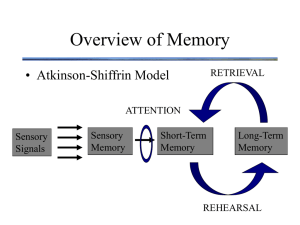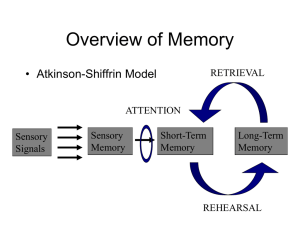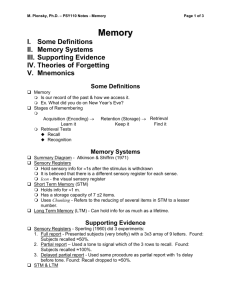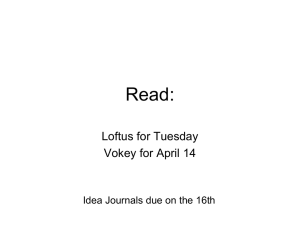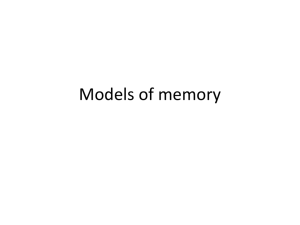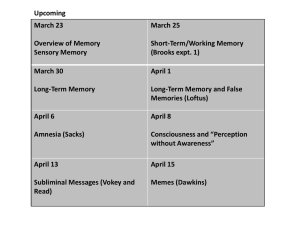Overview of Memory • Atkinson-Shiffrin Model RETRIEVAL ATTENTION
advertisement
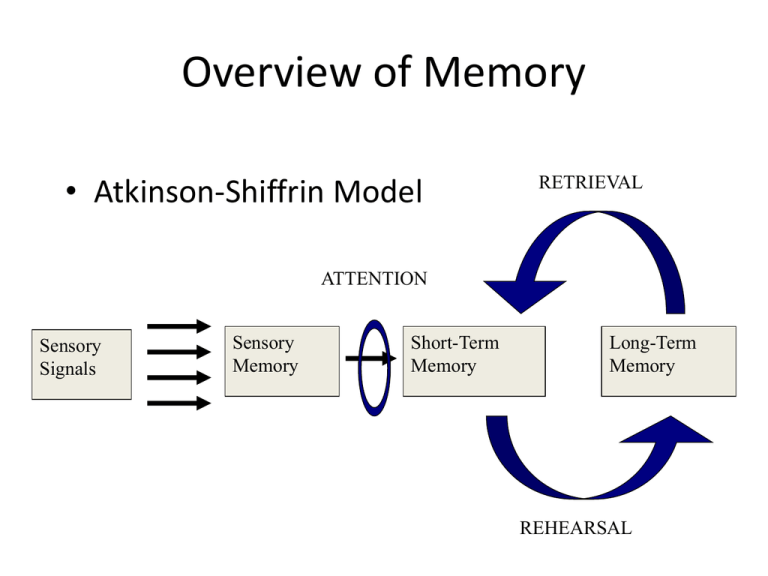
Overview of Memory • Atkinson-Shiffrin Model RETRIEVAL ATTENTION Sensory Signals Sensory Memory Short-Term Memory Long-Term Memory REHEARSAL Sensory Memory Supplementary reading: •Cognition (on reserve) • Averbach and Sperling (course pack) Part 1 Capacity • Describe a simple experiment that could measure the capacity of “memory” Capacity • Describe a simple experiment that could measure the capacity of “memory” • Briefly present some letters or digits and then ask the subject to report them – Called “whole report” Capacity + Capacity F S F E G S+ A U T O C G Capacity “Recall as many letters as you can” Capacity • George Sperling - Systematic investigation of memory capacity – Result: subjects accurately recall about 4 items – What can you conclude from this result? – Maybe subjects can only hold about 4 items? Capacity • Could it be that subjects had encoded all the letters but failed to retrieve the information? Capacity • For example: What if they forgot the information before they could report it? – You would get the same result! • How could you modify the experiment to measure the instantaneous capacity, before any forgetting can occur? Capacity • Partial Report - briefly present letters or digits and ask subject to report only some of them “Report the letters in the row indicated by the arrow” Capacity + Capacity U E S B O D+W A I B V S Capacity + Capacity Which Letters? Capacity • Partial Report • Result: subjects can recall any 4 letters that are indicated by the arrow ! Capacity • Partial Report • Result: subjects can recall any 4 letters that are indicated by the arrow ! • What does this mean about the capacity of memory? Capacity • There is some part of the perception system that stores huge amounts of information… – in fact, if only a single letter is probed, instantaneous capacity is seen to be unlimited Duration • There is some part of the perception system that stores huge amounts of information… • But for how long? How would you design an experiment to measure the duration of this high-capacity memory system? Duration • There is some part of the perception system that stores huge amounts of information… • But for how long? How would you design an experiment to measure the duration of this high-capacity memory system? • Vary the onset of the probe Duration • Partial Report 10 # of letters potentially recalled 4 0 0 ms 500 ms Probe Delay never Duration • Partial Report 10 # of letters potentially recalled 4 0 0 ms 500 ms never Delay Interpretation: 1. Information dwells in a brief storage “buffer” 2. duration of storage lasts about 1/2 of one second Iconic Memory • a brief storage of “raw data” in the visual system Echoic Memory • Auditory information is stored in a similar sensory “buffer” – Echoic memory seems to last for several seconds Properties of Sensory Memory 1. Brief (iconic ~500ms; echoic ~2 seconds) Properties of Sensory Memory 1. Brief (iconic ~500ms; echoic ~2 seconds) 2. Virtually unlimited capacity Properties of Sensory Memory 1. Brief (iconic ~500ms; echoic ~2 seconds) 2. Virtually unlimited capacity 3. pre-attentive Properties of Sensory Memory 1. Brief (iconic ~500ms; echoic ~2 seconds) 2. Virtually unlimited capacity 3. pre-attentive What happens if you attend to information in Sensory Memory? Overview of Memory • Atkinson-Shiffrin Model RETRIEVAL ATTENTION Sensory Signals Sensory Memory Short-Term Memory Long-Term Memory REHEARSAL Characteristics of STM • Limited Capacity – George Miller – Subject is given longer and longer lists of to-beremembered items (words, characters, digits) – Result: Subjects are successful up to about 7 “items” – Miller used the term “chunk” to refer to items in memory… » But what is a “chunk”? Capacity and Forgetting from STM • Limited Capacity – Recalling takes time ! Capacity and Forgetting From STM • Naveh-Benjamin & Ayers (1986) • Showed that apparent span of STM is reduced for items that take longer to say Capacity and Forgetting From STM • Brown (1958) and Peterson & Peterson (1959) • Subjects given list of “trigrams” • Rehearsal prevented by counting backward by threes • Showed that duration of STM is on the scale of seconds Proportion Correct 1.0 .5 .1 3 6 9 12 15 18 Delay (seconds) Capacity and Forgetting From STM • Rundus (1971) • Primacy Effect – participants more likely to recall first few items • Recency Effect – participants more likely to recall last few items Probability of Recall • Long lists of “to-beremembered” items 1.0 .5 .1 2 6 10 14 Position in list 18 24 Capacity and Forgetting from STM • Why do we “forget” from STM? – Does the memory trace decay? • not likely because with very small lists (like 1 item) retention is high for long intervals Capacity and Forgetting from STM • Why do we “forget” from STM? – Does the memory trace decay? • not likely because with very small lists (like 1 item) retention is high for long intervals – Instead, it seems that information “piles up” and begins to interfere Capacity and Forgetting from STM • Interference in STM is complex and specific

